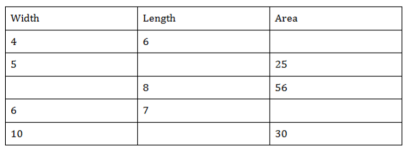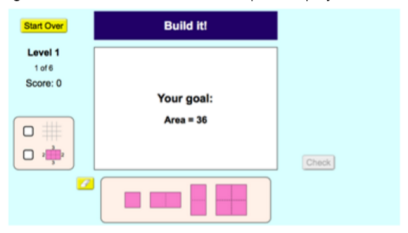What’s My Area Lesson Plan: PhET Area Builder Simulation
Submitted by: Rachel Ortega
In this lesson plan, students use an interactive simulation to investigate the mathematical science of area and the different ways to calculate and find area. Area is defined as the amount of space a 2-D object takes up, measured in unit squares.
Students will:
- Investigate and calculate area.
Materials:
- Computers or other devices with Internet access
Vocabulary:
Preparation:
This lesson features an interactive simulation titled Area Builder, developed by our award-winning partner PhET through the University of Colorado Boulder. The simulation challenges students to build shapes and explore the relationship between area and perimeter through two types of challenges: “Build a Shape” and “Find the Area.” Each type of challenge includes increasing levels of difficulty.Watch the Area Builder video primer for an introduction to the Area Builder simulation’s features and uses. Then watch the Area Builder Simulation Overview for a summary of the of sim controls, model simplifications, and insights into student thinking.
Preview and play with the Area Builder simulation to plan how you will adapt it to your students’ needs. If students will be working in small groups, review tips on Setting Cooperative Gaming Expectations.
Depending on your classroom routines and available technology, you may want to consider these grouping options:
- 1:1 with students and devices
- Two to three students sharing one device and swapping ideas and the device back and forth
- Station model where small groups rotate through using the devices.
Build background knowledge or reinforce topics with these BrainPOP movies: Area of Polygons, and Geometry. BrainPOP Jr also offers a movie about Area.
Lesson Procedure:
- Explore. Begin by having students open the Area Builder simulation and click the Explore option in the simulation. Encourage students to freely explore different shapes by placing square units on the grid (other way sounds repetitive). Tell them that the unit squares going horizontal are called “wide” or “width” and the ones going vertically are called “long” or “length.”
- Point out the box at the top of the screen that dynamically shows the area and perimeter of the shape they’re constructing. Have them hide the area and perimeter values by clicking the “-” and then have them reappear by clicking the “+” button. The screen should look like this when you hide the perimeter:

- Question Prompts. Prompt exploration by having students answer these questions as they play with the simulation:
- Hypothesize. Ask students to hypothesize whether there is a relationship between given dimensions and the area of a shape. Have them write down their hypothesis.
- Explain. Instruct students to clear the grid and hide the perimeter and area. Have them create the following table in their notebooks and use the simulation to complete it. When the table is complete, have them state a rule about the relationship between dimensions and area.
 Next, have students use their rule to answer the following question: If I build a shape that has a width of 4 square units and a length of 7 square units, what is the area?
Next, have students use their rule to answer the following question: If I build a shape that has a width of 4 square units and a length of 7 square units, what is the area? - Apply. Now guide students to click the Game option to play Level 1.

- Have them create the following table in their notebooks, and use it to record area, width and length as they play:

- Conclude. Compare the data from different problems and explain the relationship between width, length and area.











